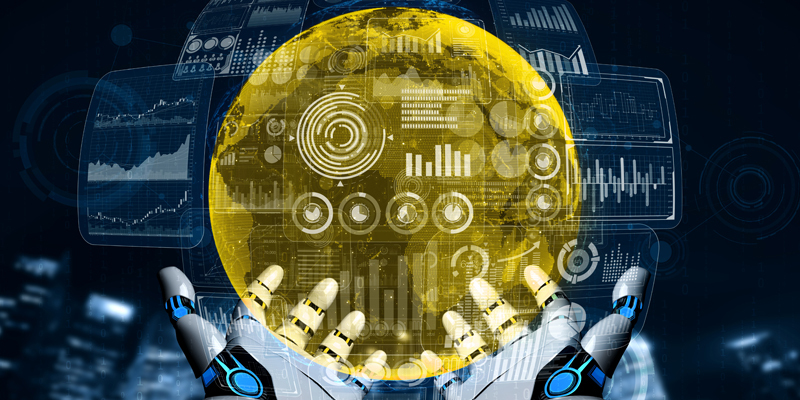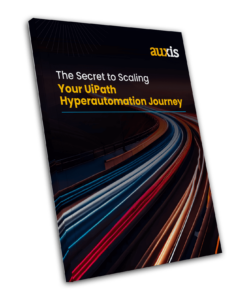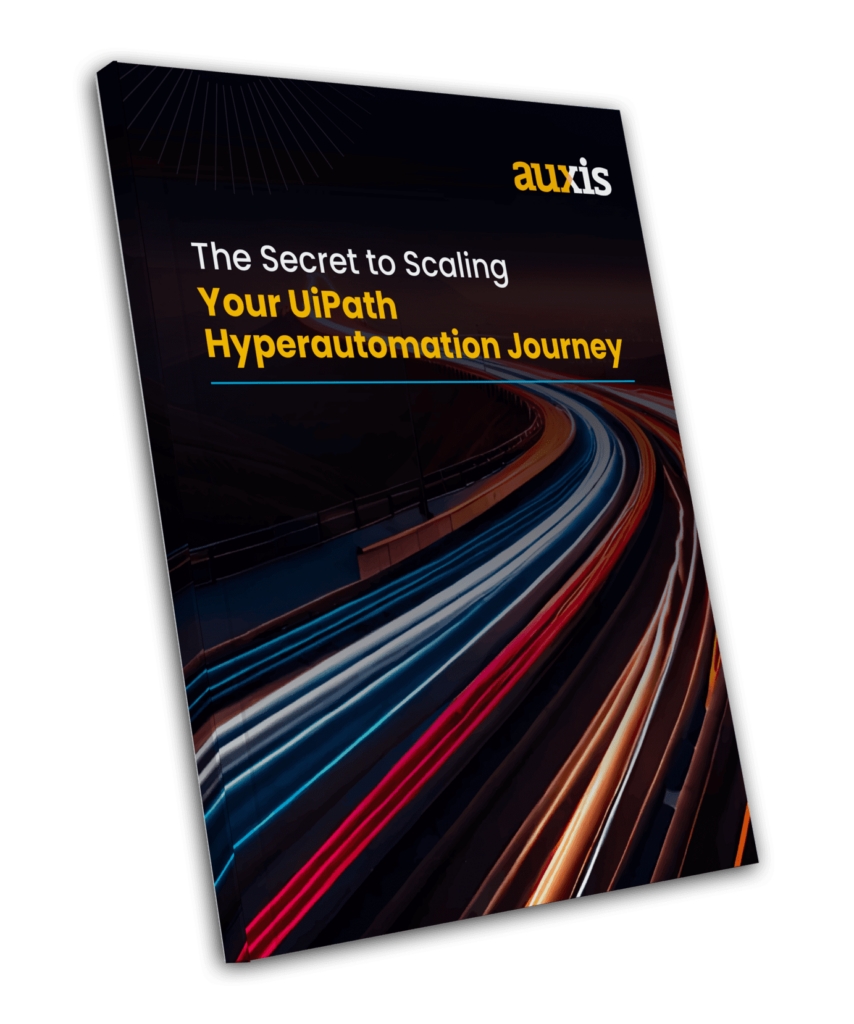In the wake of the pandemic, urgent demand for digital business models shifted the need for hyperautomation from “optional to vital,” Gartner writes. But despite the technology’s buzz, confusion often swirls around what is hyperautomation – and what it really means for a business.
At Auxis, we see hyperautomation with UiPath, the market-leading Robotic Process Automation (RPA) platform, as the inevitable next step for business operations – delivering the efficiency, speed, agility, and resiliency that organizations need to thrive in the modern business world.
Hyperautomation quickly and cost-effectively resolves issues caused by legacy business processes and technology that is not streamlined or connected. It makes it easier for business leaders to see how functions, processes, and key performance indicators interact to drive value.
But perhaps most important, hyperautomation is a means for real digital transformation – delivering the ability to automate complex tasks which previously required subject matter experts, and even work which was not possible before.
Despite the challenge of recent fiscal years, 85% of Gartner’s clients planned to increase or sustain hyperautomation investment strategies in 2022. At the end of 2021, UiPath reported a dollar-based net retention rate of 144%; in other words, its average customer increased spending by 44% from the previous year driven by the benefits it experienced.
The power and flexibility offered by hyperautomation for transforming business processes earned it another top spot on Gartner’s annual ranking of the hottest tech trends in 2022, with Gartner calling its growth “relentless.” Read on to learn more about why hyperautomation can be the game-changer your business needs to compete in the post-pandemic era.
But really, what is Hyperautomation?
RPA is the core enabling technology of hyperautomation, but it cannot deliver hyperautomation by itself. In fact, most executives who express frustration with robots say they are too rigid and cannot handle the real day-to-day complexities of a business.
To solve this problem, hyperautomation harnesses the power of RPA along with multiple technologies for end-to-end automation. It marries RPA with AI tools – orchestrating the use of a range of technologies, tools, and platforms to move beyond an RPA journey’s initial low-hanging fruits and automate virtually any repetitive task executed by business users.
Upskilling RPA with a strong intelligent data capture engine, open APIs, cognitive capabilities, affordable real-world Machine Learning (ML) models, and seamless interaction between humans and robots takes automation to the next level – improving processes in ways that have greater impact than traditional RPA capabilities.
Ultimately, hyperautomation creates an intelligent digital workforce that can supplement employee performance, connect to an array of business applications, operate with structured and unstructured data, analyze information and make decisions, discover processes and new automation opportunities, and more.
By 2024, Gartner predicts that combining hyperautomation and redesigned processes will drop operational costs by 30%.
At Auxis, we see hyperautomation as a company-wide initiative to unlock automation’s full potential – increasing efficiency and productivity by automating all tasks that don’t add value to your customers or provide a poor customer/employee experience.
Naturally, this can mean something very different to each organization. Finding the right balance between investment and productivity is the most common question executives are looking to answer as they embark on this journey: what does hyperautomation mean to us?

Hyperautomation with UiPath: Leveraging the leading platform on the market
As hyperautomation redefines the way business works, the UiPath platform shines as the leading product on the market for delivering an end-to-end solution in Intelligent Automation. UiPath has long been a leader in RPA innovation – trailblazing new capabilities for cloud, embedded analytics, attended bots, citizen development, and more.
As such, its offerings stretch from opportunity identification and evaluation to a fully controlled, scalable, and measurable automation environment – adding productivity and efficiency to business problems beyond the rules-based, repetitive, transaction processing commonly paired with RPA.
Understanding the complete capabilities of the UiPath platform – and having the right talent and governance to deploy it effectively – is key to unlocking the true potential of hyperautomation for your company’s digital transformation.
True to form, UiPath recently became the first company of scale to leverage AI-powered automation discovery. Its Task Mining solution uses advanced ML models to pinpoint frequent task patterns and identify repetitive activities that can be automated without interrupting employees’ work.
Advanced process mining tools are also now integrated with UiPath’s Automation Hub, helping users identify and implement automations that create instant operational improvements.
UiPath continues to rapidly increase its already impressive AI capabilities, offering its own AI Center as well as the ability to integrate AI from different sources. Its functionality expands beyond predictive analysis in RPA solutions to increase the reach of automations with capabilities like Chatbots and AI Computer Vision that lets bots see on-screen elements with human-like recognition.
Other recent releases further strengthen UiPath’s leadership in the march toward enterprise-wide hyperautomation. Recent additions include:
- Document Understanding, which combines RPA and AI to help organizations extract and interpret data from different documents and ensure end-to-end processing.
- AI Fabric with Model Retraining, allowing exceptions and corrections to help robots get even better at their jobs over time.
- Task Capture, a process discovery tool that accelerates business process documentation by recording regular workflows in detail.
- Test Suite, automating and centralizing testing to ensure the quality of every automation and application before it goes live.
- StudioX, enabling all employees to chip in as citizen developers by automating their tasks.
- An Integration Service that makes UiPath the first automation provider to offer best-in-class, enterprise-grade, UI-based and API-based automation capabilities that can be used seamlessly together.
- Long Running Workflows that facilitate seamless interaction between humans and unattended bots when human judgment is required.
- Out-of-the-box, drag-and-drop Machine Learning models that can be consumed by any size organization.
- A new version of UiPath Assistant that allows an RPA Center of Excellence to effortlessly deploy automation to different user groups and track utilization and productivity gains from all attended users.
- Automation scheduling and robot auto-healing eliminate human involvement.
- A Picture-in-Picture mode that lets employees continue other work on a machine running an automation process that requires user interface.
Unlock the full potential of UiPath hyperautomation with an exceptional partner
As competitive pressures for efficiency, efficacy, and business agility intensify, hyperautomation unlocks maximum potential for an automated enterprise. Led by UiPath, Gartner expects the worldwide market for technology that enables hyperautomation to reach $596.6 billion in 2022 – up from $481.6 billion in 2020.
But achieving hyperautomation remains easier said than done. Only 35% of organizations have managed to successfully automate more than a handful of processes, according to the 2020 Shared Services & Outsourcing Network (SSON) report.
Amplifying your ability to automate rests on understanding what is hyperautomation and the complete capabilities of your RPA platform, following best practices, and finding an exceptional and experienced partner to support your journey. More and more businesses are turning to dedicated third-party partners for their hyperautomation programs, realizing the critical need for skills that aren’t available in-house to scale an intelligent digital workforce company-wide.
Unlocking the full potential of automation requires more than deploying robots to follow simple rules. With the right hyperautomation partner, enterprises can ensure their organizations are future-proof – building a sophisticated and intelligent digital workforce that evolves and grows with your enterprise.
To learn more tips for achieving hyperautomation successfully, be sure to check out our whitepaper: “ The Secret to Scaling Your UiPath Hyperautomation Journey.”




